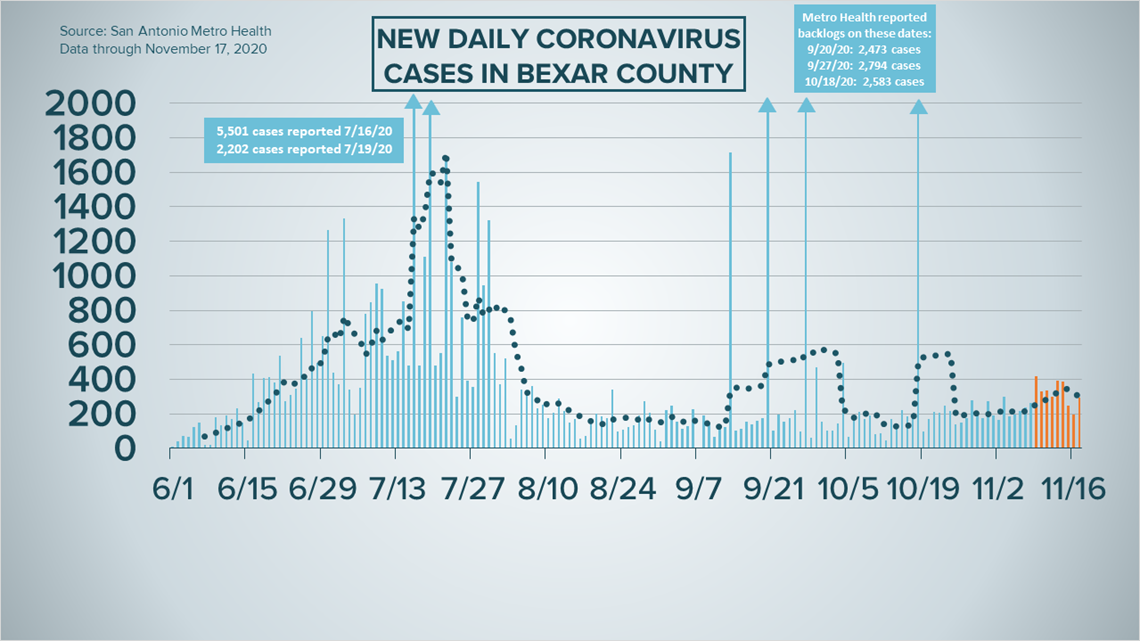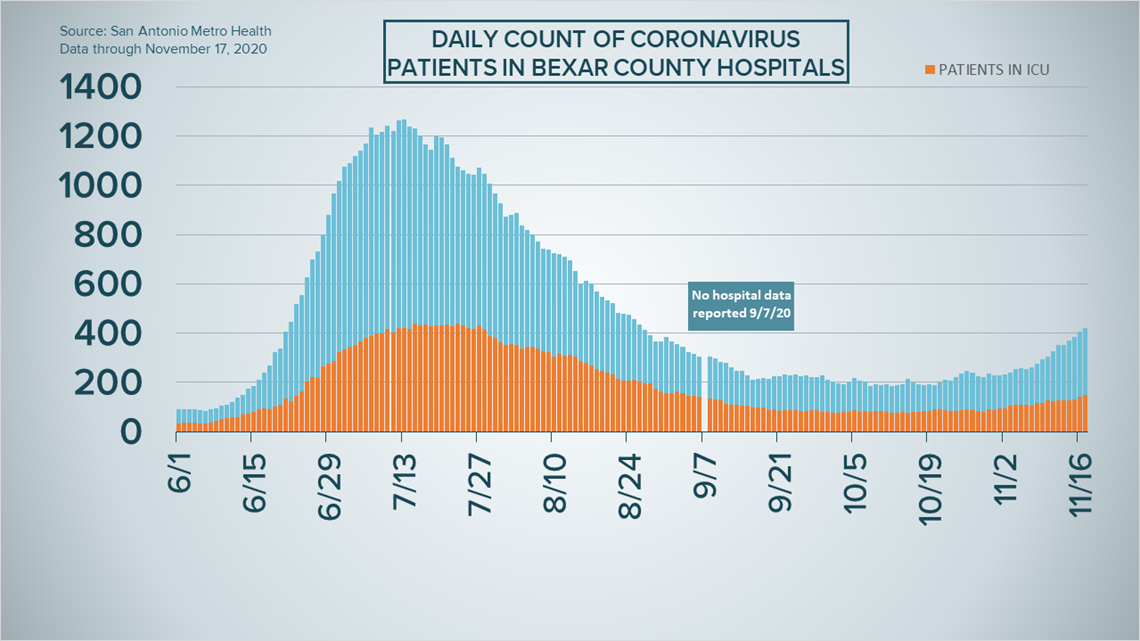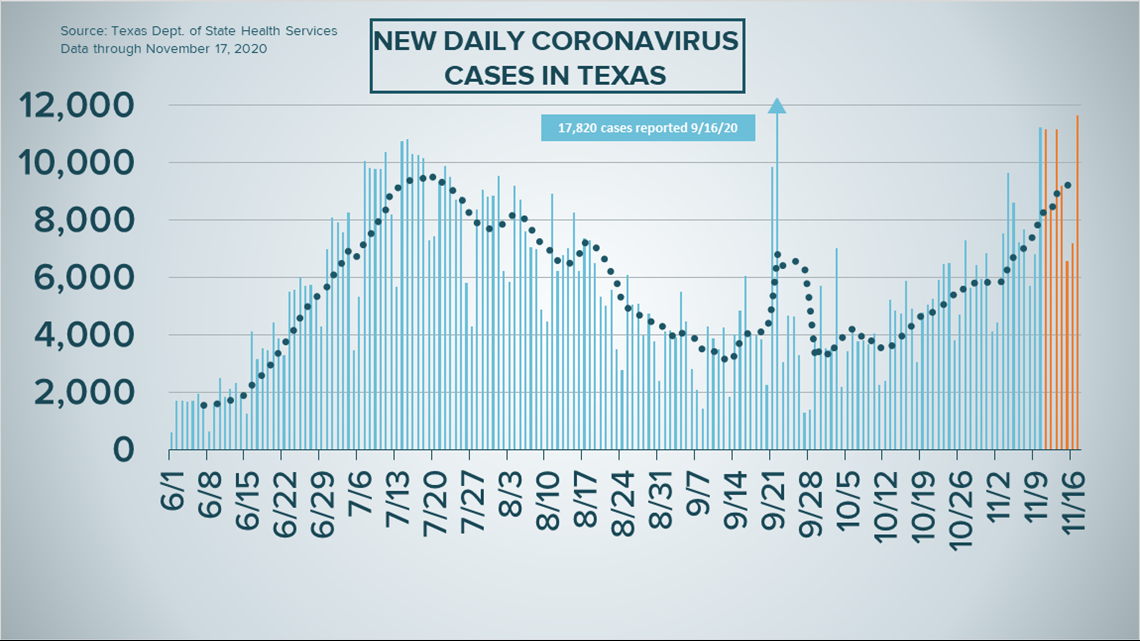SAN ANTONIO — We're tracking the latest numbers from the coronavirus pandemic in San Antonio and across Texas. Here are the latest numbers reported by Bexar and surrounding counties:
- Bexar County: 292 new cases were reported Tuesday, bringing the total number of cases for the county to 70,528. Three new deaths were also reported, bringing the death toll to 1,304.
- Comal County: The county reported 45 new COVID-19 cases Thursday. One new virus-related death was reported. There have been a total of 4,288. reported cases of COVID-19 in the county – including 3,079 lab-confirmed cases – while 125 county residents have died. County officials say there are 372 active coronavirus cases, and 3,791 residents are considered recovered.
- Hays County: Officials in Hays County on Tuesday reported 78 new cases in the county. As of Tuesday, there are a total of 6,798 lab-confirmed cases in the county (636 of which are active), while the death toll remained at 92. 6,070 residents have recovered from the virus.
More county case information is available through the Texas Department of Health Services COVID-19 dashboard.
How Bexar County is trending
We've tracked how many coronavirus cases have been confirmed in Bexar County from the time officials began reporting cases in March 2020. The graphic below shows the number of cases since June and charts those daily case numbers along a 7-day moving average to provide a more accurate picture of the overall coronavirus case curve in our area and the direction we're trending amid the pandemic.
San Antonio Mayor Ron Nirenberg reported an additional 292 coronavirus cases in Bexar County, bringing the total number of local infections to 70,528 since the pandemic began. The county's seven-day moving average for newly reported cases is now 291 per day, according to city officials.


Three new deaths were reported Tuesday, bringing the total number of Bexar County residents who have died from COVID-19 complications to 1,304.
Meanwhile, the number of local COVID-19 patients hospitalized rose to 422 on Tuesday, the highest number of hospitalizations since 436 were being treated on August 26. Of the 422 patients, 65 are on ventilators and 149 are in ICU. That's the most patients in local ICUs since September 3.
As of Tuesday, 67 of the total patients in Bexar County hospitals were patients from El Paso.


In his weekly update on the county's COVID-19 risk level, Nirenberg noted the 14-day decline in the number of reported cases remains 'critical,' while the positivity rate jumped a full percentage point to 9.4% -- that number is better than when cases peaked in July, Nirenberg said, but it is still "important to reverse that trend."
Coronavirus in Texas
The total number of novel coronavirus cases in the state since the pandemic began grew by 11,624 on Tuesday, according to the Texas Department of State Health Services. That rise includes 798 cases attributed to backlogs that were previously not included in the state's total. (More details can be found at the top of this page.)
The state's 7-day moving average for newly reported cases is now 9,326. The peak 7-day average during July's COVID-19 surge was 9,469 new cases per day, on July 17.
As of Tuesday, just over one million Texans have contracted COVID-19.


State health authorities also reported 117 additional virus-related deaths on Tuesday. The state has reported least 19,696 Texans have passed away from COVID-19 complications; Johns Hopkins data collected Monday for Texas indicates the state surpassed 20,000 fatalities, making it the second state in the United States to do so.
On Tuesday, the overall number of Texans hospitalized for COVID-19 jumped by 373, bringing the current total to 7,841. Last week, that number passed 7,000 for the first time since early August.
Since the beginning of November, the number of Texas hospitalizations have gone up by 37.7%, continuing a trend that began in early October that indicates a resurgent virus spread in the Lone Star State.
The state estimates that 883,223 Texans have recovered, while 139,048 Texans remain ill with COVID-19.
Meanwhile, the latest update from the Texas Education Agency showed that there have been 39,291 cumulative cases among staff and students across the state through Nov. 8. More information can be found here.
The TEA releases new data on school cases every Thursday.
Latest Coronavirus Headlines
- Judge Wolff may close bars following recommendations from county experts
- Mardi Gras parades don't meet COVID guidelines, won't happen in 2021 city says
- Dolly Parton helps fund nearly 95% effective COVID-19 vaccine
- COVID-19 task forces: Who's on Biden's and Trump's?
- Double lung transplant, COVID-19 survivor 'a walking miracle'
- Pandemic politics leave DC in gridlock as coronavirus surges
- More than 1 million US children test positive for COVID-19
- Report: Pfizer picks Texas for COVID-19 vaccine pilot delivery program
Coronavirus symptoms
The symptoms of coronavirus can be similar to the flu or a bad cold. Symptoms include fever or chills, cough, shortness of breath or difficulty breathing, fatigue, muscle or body aches, headache, new loss of taste or smell sore throat, congestion or runny nose, nausea or vomiting and diarrhea, according to the Centers for Disease Control.
Most healthy people will have mild symptoms. A study of more than 72,000 patients by the Centers for Disease Control in China showed 80 percent of the cases there were mild.
But infections can cause pneumonia, severe acute respiratory syndrome, kidney failure, and even death, according to the World Health Organization. Older people with underlying health conditions are most at risk.
But infections can cause pneumonia, severe acute respiratory syndrome, kidney failure, and even death, according to the World Health Organization. Older people with underlying health conditions are most at risk.
Experts determined there was consistent evidence these conditions increase a person's risk, regardless of age:
- Chronic kidney disease
- COPD (chronic obstructive pulmonary disease)
- Obesity (BMI of 30 or higher)
- Immunocompromised state (weakened immune system) from solid organ transplant
- Serious heart conditions, such as heart failure, coronary artery disease, or cardiomyopathies
- Sickle cell disease
- Type 2 diabetes
The CDC believes symptoms may appear anywhere from two to 14 days after being exposed.
Human coronaviruses are usually spread...
- Between people who are in close contact with one another (within about 6 feet).
- Through respiratory droplets produced when an infected person coughs, sneezes or talks. These droplets can land in the mouths or noses of people who are nearby or possibly be inhaled into the lungs.
- Some recent studies have suggested that COVID-19 may be spread by people who are not showing symptoms.
Help stop the spread of coronavirus
- Stay home when you are sick.
- Eat and sleep separately from your family members
- Use different utensils and dishes
- Cover your cough or sneeze with your arm, not your hand.
- If you use a tissue, throw it in the trash
Find a Testing Location
City officials recommend getting a COVID-19 test if you experience fever or chills, cough, shortness of breath or difficulty breathing, fatigue, muscle or body aches, headache, new loss of taste or smell, sore throat, congestion or runny nose, nausea or vomiting, or diarrhea.
San Antonio operates several no-cost testing locations, including two walk-up locations open Monday-Sunday from 10 a.m. until 2 p.m.:
Cuellar Community Center
5626 San Fernando St.
San Antonio, TX 78237
Ramirez Community Center
1011 Gillette Blvd.
San Antonio, TX 78224
Additionally, Freeman Coliseum offers drive-through no-cost testing from Monday through Sunday between 9 a.m. and 4 p.m. An appointment is required and can be made either online or by calling (833) 213-0643.
Here's a Testing Sites Locator to help you find the testing location closest to you in San Antonio.

